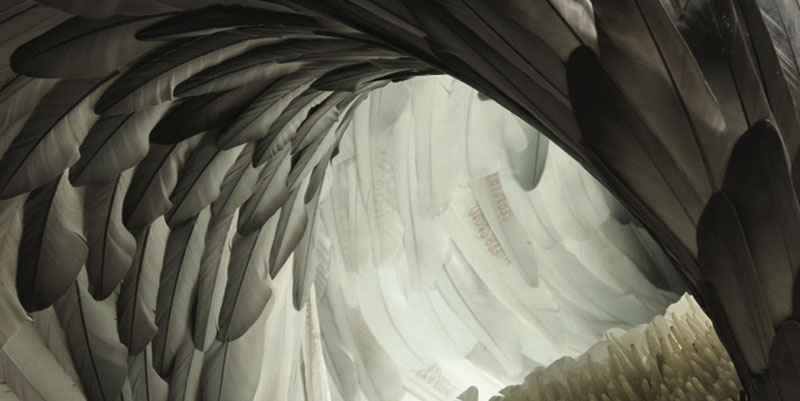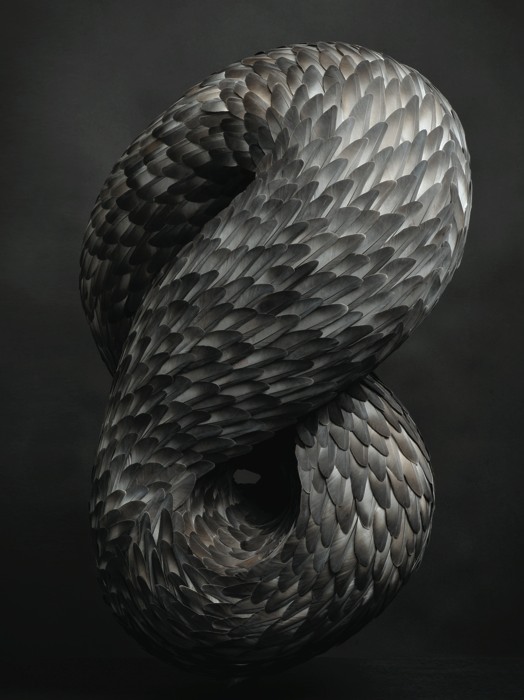I was brought up on the Norfolk Broads, surrounded by wildlife – by flocks of native and migrating birds, calling, nesting, swooping and circling overhead. That connection with water and birds has never left me, and today my studio is a barge moored on the River Thames, next to a semi-derelict warehouse filled with feral pigeons.
As a child I was always making things, constructing and deconstructing the world around me. For me it was a way to understand the world and make it my own. Occasionally we’d make family trips up to London, where a favourite place to visit was the British Museum. I remember in particular seeing the relics from Tutankhamen’s tomb and the Japan Exhibition, which was like nothing I’d ever seen before. These shows seemed to light something inside me, firing my fascination with art and objects. Later, when I moved to Paris aged 16 to work as an au pair, the city’s galleries were where I spent much of my spare time and learnt how to ‘look’.
In a way my work is a sort of process without end – a ceaseless cycle of collection and creation. While the making can take anything from a couple of weeks to a few months the collection of the materials can take years. I create the basic form on paper first – I’ll often sketch an idea with no immediate plan as to how to use it. Working in this way allows me free rein of shape and scale, and to experiment in a way that is impossible when using actual materials. The feathering stage is much more like painting; it’s at once fluid and expressive, and requires meticulous attention to detail. It’s also highly meditative. So much so that I often become completely immersed in the act of making; I often look back at a finished piece of work and think, ‘Did I make that?’ As if the work takes on a life of its own.
The pigeon feathers come from a network of pigeon-racing enthusiasts I’ve been building up over the last five years. By necessity I’ve had to become fully conversant with the pigeon-racing world and I can’t tell you how supportive they’ve been. I once took a stand at one of the annual pigeon shows in the far North-East of England; people were asked to bring along bags of feathers and in return got their names put into a hat to win a work. It all felt a bit incongruous but I was made to feel very welcome – the racing fraternity seems to love the fact that I’m making something beautiful out of their precious birds’ moultings. The birds shed their feathers twice a year, in April and October, so there are just two brief windows of time in which to gather my materials.
The business of collecting the feathers and creating a work feels satisfyingly intertwined, and creates a kind of virtuous circle all of its own. Relying on the goodwill of a whole network of individuals gives a human dimension to the process, which is mirrored in the many hands required to complete the work. The crow, jackdaw and magpie feathers come from local gamekeepers; the farmers, whose crops they destroy, may consider them predators or pests, but the birds are appreciated – at least by me. That dichotomy between the birds’ reputations – and the loathing they inspire – and their feathers’ physical beauty and value to me as an artist is a crucial component of the material’s fascination for me; that ability for it to be both one thing and another gives an extra layer of meaning to my work, making the feather a useful metaphor for the duplicity of nature, a theme that sits at the core of my work.
I feel very physically connected to my materials, perhaps because I spend so many hours cleaning and sorting them. I’ve realised down the years that the preparation time is as much a part of the creative process as the actual making. It’s while I’m handling the feathers that I’m able to reflect on the work(s) I’m about to make, giving me crucial thinking time before I commit anything to paper. The mind is a malleable canvas, while physical mistakes can be hard to undo.
The feathering stage is compelling, hypnotic; I can happily lose myself in it for hours. It’s also instinctual – you can’t plan how to lay the feathers out nor can you really teach someone. Each feather contributes to the overall patterning of a piece, and it’s this implicit sense of movement in the shifting colours and gentle curve of each filament that brings the work to life. This final stage draws on the rituals of craft, on the connection between hand and eye and the natural serendipity that happens when you become fully immersed in giving life to an idea. It’s my favourite part of the process. And because it makes me so in tune with a piece it makes the finished work hard to let go.
Kate MccGwire









